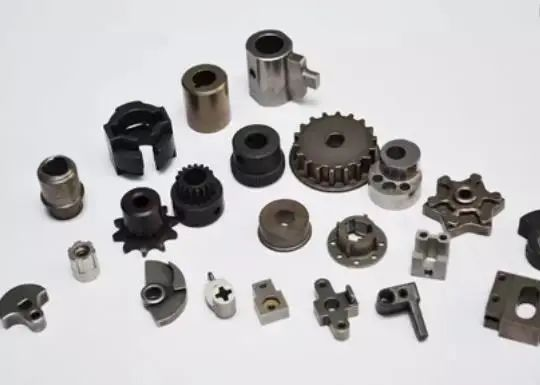Heat treatment process of powder metallurgy
Nov. 11, 2023
The heat treatment of powder metallurgy materials should be determined based on their chemical composition and grain size. The presence of pores is an important factor. During the pressing and sintering process of powder metallurgy materials, the pores formed run through the entire part. The existence of pores affects the way of heat treatment. and effect.
The heat treatment of powder metallurgy materials includes quenching, chemical heat treatment, steam treatment and special heat treatment:
1)Quenching heat treatment process
Due to the existence of pores, powder metallurgy materials have lower heat transfer rates than dense materials, so their hardenability is relatively poor during quenching. In addition, during quenching, the sintering density of powder materials is directly proportional to the thermal conductivity of the material; due to the difference between the sintering process and dense materials, the internal structure uniformity of powder metallurgical materials is better than that of dense materials, but there are smaller microscopic areas. Inhomogeneity, so the complete austenitization time is 50% longer than that of the corresponding forging. When alloying elements are added, the complete austenitization temperature will be higher and the time will be longer.
In the heat treatment of powder metallurgy materials, in order to improve the hardenability, some alloying elements such as nickel, molybdenum, manganese, chromium, vanadium, etc. are usually added. Their function is the same as that in dense materials, and they can significantly refine the crystal. Grains, when dissolved in austenite, will increase the stability of supercooled austenite, ensure the austenite transformation during quenching, increase the surface hardness of the material after quenching, and increase the quenching depth. In addition, powder metallurgy materials must be tempered after quenching. The temperature control of the tempering treatment has a greater impact on the performance of the powder metallurgy materials. Therefore, the tempering temperature must be determined according to the characteristics of different materials to reduce the impact of temper brittleness. General materials can be tempered in air or oil at 175-250°C for 0.5-1.0 h.

2)Chemical heat treatment process
Chemical heat treatment generally includes three basic processes: decomposition, absorption, and diffusion. For example, the reactions of carburizing heat treatment are as follows:
2CO≒[C]+CO2 (Exothermic reaction)
CH4≒[C]+2H2 (Endothermic reaction)
1) After the carbon is decomposed, it is absorbed by the metal surface and gradually diffuses into the interior. After the surface of the material obtains a sufficient carbon concentration, it is then quenched and tempered, which will increase the surface hardness and hardening depth of the powder metallurgy material. Due to the existence of pores in powder metallurgy materials, activated carbon atoms penetrate into the interior from the surface to complete the chemical heat treatment process. However, the higher the density of the material, the weaker the pore effect, and the less obvious the effect of chemical heat treatment. Therefore, a reducing atmosphere with a higher carbon potential must be used for protection. According to the pore characteristics of powder metallurgy materials, their heating and cooling speeds are lower than those of dense materials, so the holding time must be extended and the heating temperature must be increased during heating.
2) Chemical heat treatment of powder metallurgy materials includes several forms such as carburizing, nitriding, sulfurization and multi-component co-infiltration. In chemical heat treatment, the hardening depth is mainly related to the density of the material. Therefore, corresponding measures can be taken in the heat treatment process, such as: when carburizing, the time is appropriately extended when the material density is greater than 7g/cm3. The wear resistance of the material can be improved through chemical heat treatment. The uneven austenite carburizing process of powder metallurgy materials can make the carbon content on the surface of the carburized layer of the treated material reach more than 2%, and the carbides are evenly distributed on the surface of the carburized layer. , can well improve the hardness and wear resistance.
3)Steam treatment
Steam treatment is to oxidize the surface of the material by heating steam to form an oxide film on the surface of the material, thereby improving the performance of the powder metallurgy material. Especially for the anti-corrosion of the surface of powder metallurgy materials, its validity period is more obvious than that of bluing treatment, and the hardness and wear resistance of the treated materials are significantly increased.
4)Special heat treatment process
Special heat treatment processes are the product of technological development in recent years, including induction heating quenching, laser surface hardening, etc. Induction heating quenching is under the influence of high-frequency electromagnetic induction eddy current. The heating temperature increases quickly and has a significant effect on increasing surface hardness. However, soft spots are prone to occur. Generally, intermittent heating can be used to extend the austenitization time; laser surface hardening The process uses laser as the heat source to rapidly heat and cool the metal surface, so that the substructure inside the austenite grains does not have time to recover and recrystallize, thereby obtaining an ultra-fine structure.










